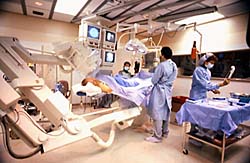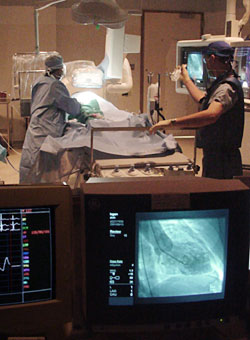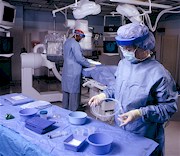Related terms: cardiac cath, heart cath, cath lab, angiography, arteriography

Cardiac catheterization is a method doctors use to perform many tests and procedures for diagnosing and treating coronary artery disease. Cardiac catheterization is used for diagnostic tests such as angiography, arteriography, and electrophysiology studies (EPS).
How does it work?
The method involves threading a long, thin tube (called a catheter) through an artery or vein in the leg or arm and into the heart. Depending on the type of test your doctor has ordered, different things may happen during cardiac catheterization. For example, a dye may be injected through the catheter to see the heart and its arteries (a test called coronary angiography or coronary arteriography). Also, electrical impulses may be sent through the catheter to study irregular heartbeats (tests called electrophysiology studies).
Doctors can use the catheterization method along with angiography and arteriography to see the vessels in the rest of your body as well. For example, they may perform a test called carotid arteriography to see the vessels leading to the brain. Often, doctors use the terms cardiac catheterization, angiography, and arteriography to mean the same thing.
What should I expect?
Patients are usually told not to eat or drink anything after midnight the night before the test. If you have diabetes, you should talk to your doctor about your food and insulin intake, because not eating can affect your blood sugar levels.
Talk to your doctor about any medicines (prescription, over-the-counter, and supplements) that you are taking because he or she may want you to stop taking them before the test. This is especially important if you are taking blood-thinning medicines or anti-platelet medicines. It may be helpful to make a list of your medicines and bring it with you to the procedure, so that the doctors know exactly what you are taking and how much. You will most likely have blood tests, an electrocardiogram, and a chest x-ray taken before the procedure.
|

|
|
View from the control room of a cath lab.
|
Once you are in the catheterization laboratory (also called the cath lab), you will see television monitors, heart monitors, and blood pressure machines. You will lie on an examination table, which is usually near an x-ray camera.
Small metal disks called electrodes will be placed on your chest. These electrodes have wires called leads, which hook up to an electrocardiogram machine. This machine will monitor your heart rhythm during the test.
To prevent infection, you will be shaved and cleansed around the area of your leg where the catheter will be inserted.
A needle with a tube connected to it will be put in your arm. This is called an intravenous line or IV. You will get a mild sedative through the IV to relax you throughout the test.
You will be given an anesthetic medicine with a needle to numb the area around where the catheter will be inserted. You may feel mild discomfort. Then, a small incision will be made in the skin. Once doctors see the artery into which the catheter will go, a special needle is used to poke into it. Doctors then put the catheter into the artery in your leg. You should not feel pain during this part of the test.
The catheter is gently threaded through the artery and into your heart. At this point, doctors may perform angiography, arteriography, EPS, or another procedure. After doctors have the information they need, the catheter and IV will be removed. Firm pressure will be applied to the site where the catheter was inserted to stop any bleeding. You will also be bandaged.
You will be moved to another room where you will need to rest for a few hours. You may feel a little sleepy until the sedative has worn off. You should try to lie still and not bend your knee too much. Nurses will watch you to see that your heart rate and blood pressure are normal. After this time of rest, you will be able to go home.
See also on this website:
See on other sites:
MedlinePlus
https://medlineplus.gov/ency/article/003419.htm
Cardiac catheterization
Updated August 2016



